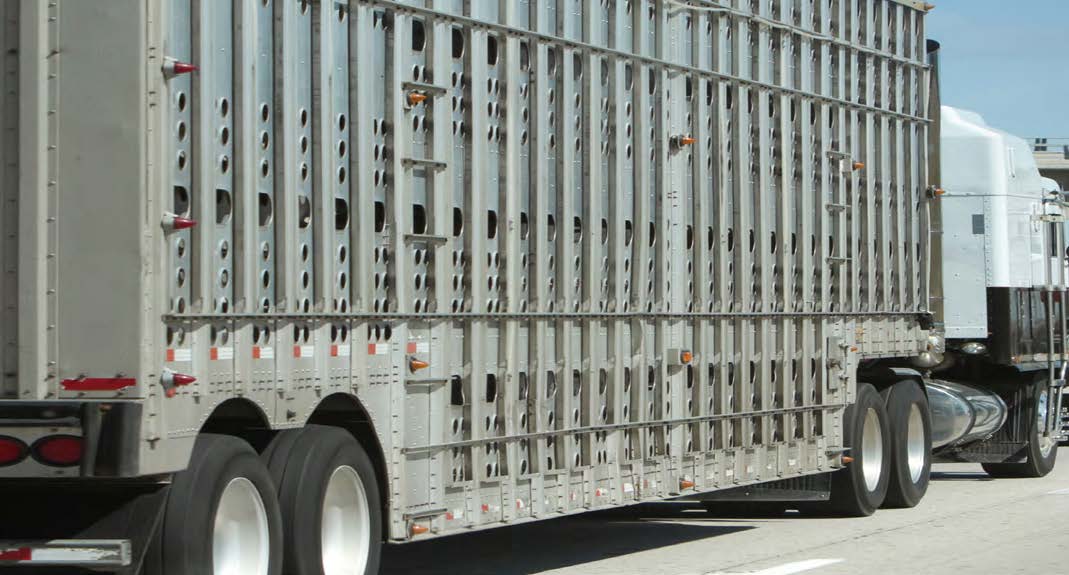

Cattle health is closely monitored in each sector of the beef and dairy industries and continuous improvement is expected from within and outside of the industries.
Fitness for transport is an important concept that applies to all cattle stages, from calves to feeders to cull cows and bulls.
This live animal evaluation is critical to deciding whether an animal is able to withstand the rigors of transport, including standing for long periods of time in variable weather.
The most visible aspect of the cattle industry is when cattle are moved across the country on wheels every day. Each stakeholder, from the cattle owner to the transporter, should strive for responsible transport decisions.

The 2022 National Beef Quality Audit shows that cattle, beef or dairy, are transported at least once and up to six times during their lifetime, so ensuring the health and welfare of these animals at each transport opportunity is a great responsibility.
Trips to the auction market, the next pasture, backgrounding or finishing feed yards, and others are each an opportunity to improve animal welfare through transportation and fitness for transport decisions.
The Beef Checkoff-funded Beef Quality Assurance Transportation (BQAT) program was designed for guidance on these topics.
The following are a few important aspects to consider when determining whether cattle are fit for transport.
Violative residues are created when animals are slaughtered before the labeled withdrawal period on the medication label.
It is important to always check treatment records and confirm animals have cleared drug withdrawal times before transporting to sale or slaughter.
Never ship an animal you do not think can withstand the rigors of transport or marketing. T
his includes not shipping extremely emaciated animals (Body Condition Score 2 or less on either beef or dairy scale) or cattle with lameness score of 3 or more (according to North American Meat Institute scale of 1-4).
Having a plan for caring for or humanely euthanizing a non-ambulatory animal should be part of your protocol since these animals cannot be slaughtered.
It is important to provide cattle access to water up until they load onto the trailer as it improves health in the short term and upon arrival.
A modest meal within 24 hours prior to transport, especially trips longer than four hours, has also been shown to improve cattle response during travel and at the destination.
This is especially important for younger calves who are more prone to dehydration in hot weather.
Duration of transport can have significant animal welfare outcomes and preparing cattle for the trip can improve response to transport stressors.
In addition, cattle may have multiple segments of their trip, so ensuring cattle can handle all legs of the trip is an important consideration when deciding to ship that animal.

During warmer months, temperature and humidity can burden or improve the transport process.
Pre-trip planning can help ensure cattle are loaded or unloaded in a cooler part of the day.
Pay close attention to the Temperature-Humidity Index to determine the risk of moving or working cattle during hotter weather.
Another consideration for younger and smaller cattle is they will need different loading densities vs. older cattle in warmer weather.
For instance, high loading densities can cause limited airflow and bruising.
Airflow is especially important for cattle welfare so if the trailer or cattle pot is unable to move or waiting in line, driving around to increase air circulation in the trailer is one option.
Animal handling is an integral piece to cattle health, especially during transportation events.
Moving animals in a low-stress, gentle, and quiet manner reduces stress on the cattle during and after transport, reducing the risk of a heat stress event.
Using acceptable handling tools such as flags or sorting sticks as an extension of yourself when needed can improve the efficiency of cattle movement.
Cattle prods should not be routinely used and only used in specific circumstances.
Any kind of abuse is not tolerated, including overuse of cattle prods.
These practices also reduce the risk of cattle going down at the plant or auction market and product defects such as dark cutters, bruising, and wasted product.
Many cull cows and bulls are culled due to a decrease in productivity and illness such as lameness. Fed animals are railed for similar reasons.
When cattle are culled proactively, these animals are in a comparatively healthier state with a slightly higher body condition and have less risk of becoming lame or going down on the trailer.
Producers are encouraged to work to cull animals earlier in the disease process like cancer eye or pneumonia or lameness, as long as drug withdrawal times are met, so animals can safely make it to their final destination without the risk of being condemned.
Proactive culling can improve the welfare of the animal in addition to having a better product.
NCBA created the Right Way. Right Time. A guide to cull cow management handout using results from the most recent audit results.
Producers and veterinarians can use this resource to evaluate their cull cattle management strategies and improve decision making with fitness for transport decisions.
Train workers to understand when animals should be humanely euthanized rather than being shipped, as an animal should not make a long transport journey only to go down on the trailer or at the plant and be euthanized then.

Even with experienced cattle producers and drivers, complacency can sink in when performance is not evaluated.
Work with a herd veterinarian, extension agent, or BQA state coordinator to conduct a self-assessment on essential skills such as humane cattle stockmanship or facility management.
Each operation has the responsibility to train their employees in cattle behavior and handling to improve cattle welfare, human safety, and work efficiency.
BQA provides a solid foundation for cattle producers and their teams so the ‘why’ is understood for quality cattle care.
Continuous improvement through consistent training only improves cattle care, human safety, and the final product.
Fitness for transport decisions influence both animal and human safety which can be adapted and improved based on the operation’s goals, workforce, and facilities.
Production Animal Consultation veterinarians have long recognized the value in employee training and one-on-one handling demonstrations and how it improves cattle care.
Other workshops such as Stockmanship & Stewardship provide live animal handling demonstrations for professional drivers, farmers, and ranchers to improve their stockmanship skills.
Upcoming events can be found at www.stockmanshipandstewardship.org.
The BQAT program provides guidance on fitness for transport for animals in addition to providing preparation steps to ensure safe trips for transporters.
More information on BQAT’s guidelines and the certification course can be found at www.bqa.org.

Dr. Julia Herman serves as the Beef Cattle Specialist Veterinarian at the National Cattlemen’s Beef Association. She has spent time in private practice in Kansas, teaching livestock medicine in the Colorado State University Veterinary Medicine program, and currently leads education development and veterinary outreach for the Producer Education team and Beef Quality Assurance (BQA) program. Her focuses include improving animal health and welfare, biosecurity, and employee education. She represents NCBA on cattle health and welfare advisory committees for national veterinary organizations and agricultural groups. Julia earned her DVM (2015) and MS (2013) from Colorado State University and is a diplomate of the American College of Veterinary Preventive Medicine.
Get all Doc Talk episodes straight to your email inbox!